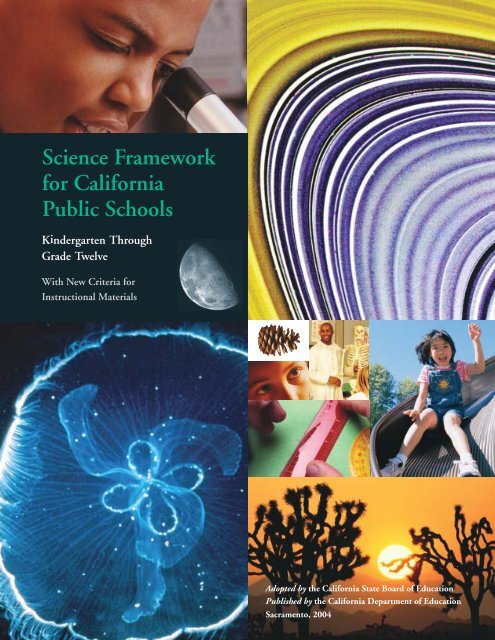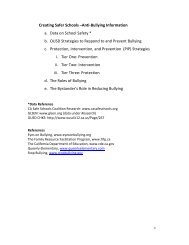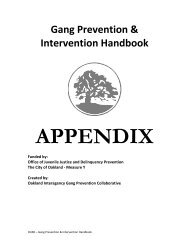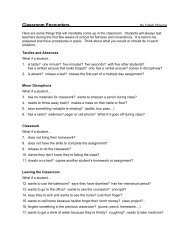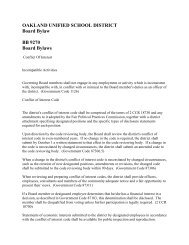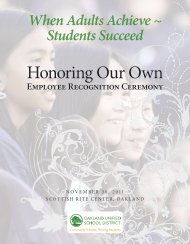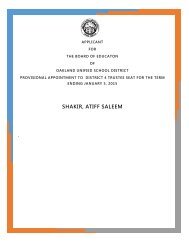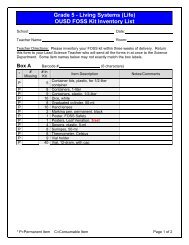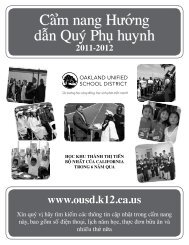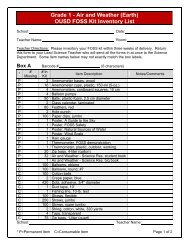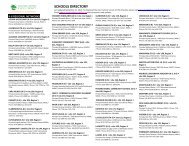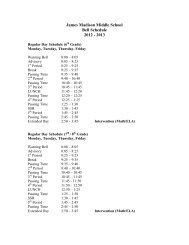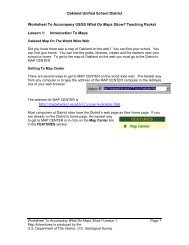Science Framework, part 1 - Free Downloads (CA Dept of Education)
Science Framework, part 1 - Free Downloads (CA Dept of Education)
Science Framework, part 1 - Free Downloads (CA Dept of Education)
- No tags were found...
You also want an ePaper? Increase the reach of your titles
YUMPU automatically turns print PDFs into web optimized ePapers that Google loves.
<strong>Science</strong> <strong>Framework</strong>for CaliforniaPublic SchoolsKindergarten ThroughGrade TwelveWith New Criteria forInstructional MaterialsAdopted by the California State Board <strong>of</strong> <strong>Education</strong>Published by the California De<strong>part</strong>ment <strong>of</strong> <strong>Education</strong>Sacramento, 2004
<strong>Science</strong><strong>Framework</strong>for CaliforniaPublicSchoolsKindergartenThroughGrade TwelveWith New Criteriafor InstructionalMaterialsDeveloped by theCurriculum Development and SupplementalMaterials CommissionAdopted by theCalifornia State Board <strong>of</strong> <strong>Education</strong>Published by theCalifornia De<strong>part</strong>ment <strong>of</strong> <strong>Education</strong>
DEPARTMENTOFEDU<strong>CA</strong>TIONSTATEOF<strong>CA</strong>LIFORNIAPublishing InformationOn March 10, 2004, the California State Board <strong>of</strong> <strong>Education</strong> approved themodified Criteria for Evaluating Instructional Materials in <strong>Science</strong>,Kindergarten Through Grade Eight, The following persons were serving onthe State Board at that time: Reed Hastings, President; Joe Nuñez, VicePresident; Ruth Bloom; Don Fisher; Ruth E. Green; Glee Johnson; JeannineMartineau; Bonnie Reiss; Suzanne Tacheny; Johnathan Williams. The newcriteria are included in this edition <strong>of</strong> the framework.When the <strong>Science</strong> <strong>Framework</strong> for California Public Schools: KindergartenThrough Grade Twelve was adopted by the California State Board <strong>of</strong><strong>Education</strong> on February 6, 2002, the members <strong>of</strong> the State Board were thefollowing: Reed Hastings, President; Joe Nuñez, Vice-President; RobertAbernethy; Donald G. Fisher; Susan Hammer; Nancy Ichinaga; CarltonJenkins; Marion Joseph; Vicki Reynolds; Suzanne Tacheny; and ErikaGoncalves.The framework was developed by the Curriculum Development andSupplemental Materials Commission. (See pages vi–viii for the names <strong>of</strong> themembers <strong>of</strong> the commission and the names <strong>of</strong> the principal writers and otherswho made significant contributions to the framework.)This publication was edited by Faye Ong and Janet Lundin, working incooperation with Greg Geeting, Assistant Executive Director, State Board <strong>of</strong><strong>Education</strong>; Tom Adams, Administrator, and Christopher Dowell, <strong>Education</strong>Programs Consultant, Curriculum <strong>Framework</strong>s and Instructional ResourcesDivision, California De<strong>part</strong>ment <strong>of</strong> <strong>Education</strong>. It was designed and preparedfor printing by the staff <strong>of</strong> CDE Press, with the cover and interior designcreated and prepared by Paul Lee. Typesetting was done by Jeannette Huffand Carey Johnson. The framework was published by the De<strong>part</strong>ment <strong>of</strong><strong>Education</strong>, 1430 N Street, Sacramento, California 95814-5901. It wasdistributed under the provisions <strong>of</strong> the Library Distribution Act andGovernment Code Section 11096.© 2004 by the California De<strong>part</strong>ment <strong>of</strong> <strong>Education</strong>All rights reservedISBN 0-8011-1599-XOrdering InformationCopies <strong>of</strong> this publication are available for $17.50 each, plus shipping andhandling charges. California residents are charged sales tax. Orders maybe sent to the California De<strong>part</strong>ment <strong>of</strong> <strong>Education</strong>, CDE Press, Sales Office,1430 N Street, Suite 3207, Sacramento, <strong>CA</strong> 95814-5901; FAX (916) 3230823.An illustrated <strong>Education</strong>al Resources catalog describing publications, videos,and other instructional media available from the De<strong>part</strong>ment can be obtainedwithout charge by writing to the address given above or by calling the SalesOffice at (916) 445-1260.Photo CreditsThe California De<strong>part</strong>ment <strong>of</strong> <strong>Education</strong> gratefully acknowledges the NationalOceanic and Atmospheric Administration for the use <strong>of</strong> the photographs onpages 34, 63, 64, 70, 73, 74, 89, 234, 259, 266, and 270; the NationalAeronautics and Space Administration for the use <strong>of</strong> photographs on pages 52,77, 81 (the background), 94, 137, 172, 251, 255, 274, and 299 (the background);and Paul A. Thiessen for theuse <strong>of</strong> the illustrations on pages 153 and 224.Prepared for publicationby CSEA members
iiiContentsForeword vAcknowledgments viState Board <strong>of</strong> <strong>Education</strong> Policy onthe Teaching <strong>of</strong> Natural <strong>Science</strong>s ix123Introduction to the<strong>Framework</strong> 1Audiences for the <strong>Framework</strong> 2Instructional Materials 3The Challenges in <strong>Science</strong> <strong>Education</strong> 3<strong>Science</strong> and the Environment 8Guiding Principles 9Organization <strong>of</strong> the <strong>Framework</strong> 13The Nature <strong>of</strong> <strong>Science</strong> andTechnology 15The Scientific Method 16Scientific Practice and Ethics 18<strong>Science</strong> and Technology 18Resources for Teaching <strong>Science</strong>and Technology 20<strong>Science</strong> and Society 20The <strong>Science</strong> Content Standards forKindergarten Through Grade Five 23Kindergarten 26Grade One 31Grade Two 36Grade Three 45Grade Four 56Grade Five 66The <strong>Science</strong> Content Standards4 for Grades Six Through Eight 81Grade Six: Focus on Earth <strong>Science</strong>s 84Grade Seven: Focus on Life <strong>Science</strong>s 103Grade Eight: Focus on Physical<strong>Science</strong>s 1255The <strong>Science</strong> Content Standards forGrades Nine Through Twelve 153Physics 156Chemistry 185Biology/Life <strong>Science</strong>s 220Earth <strong>Science</strong>s 251Investigation and Experimentation 2786789Assessment <strong>of</strong> Student Learning 281Purposes <strong>of</strong> Assessment 282<strong>Science</strong> Assessment Strategies 284STAR Program Results 285Summary 285Universal Access to the <strong>Science</strong>Curriculum 287<strong>Science</strong> and Basic SkillsDevelopment 288Academic Language DevelopmentEnglish Learners 289Advanced Learners 289Students with Disabilities 289288Pr<strong>of</strong>essional Development 293What Is Pr<strong>of</strong>essional Development? 295Who Should Teach the Teachers? 296When Is a Program Aligned with the<strong>Science</strong> Content Standards? 296When Is a Pr<strong>of</strong>essional DevelopmentProgram Deemed Successful? 297How Will Tomorrow’s <strong>Science</strong> TeachersBe Developed? 297Criteria for Evaluating InstructionalMaterials in <strong>Science</strong>, KindergartenThrough Grade Eight 299Criteria Category 1: <strong>Science</strong> Content/Alignment with Standards 302Criteria Category 2: ProgramOrganization 303Criteria Category 3: Assessment 304Criteria Category 4: UniversalAccess 304Criteria Category 5: InstructionalPlanning and Support 306Selected References309AppendixRequirements <strong>of</strong> the <strong>Education</strong> Code310
vForeword“The education <strong>of</strong> young people in science isat least as important, maybe more so, thanthe research itself.”—Glenn T. SeaborgIn 1998, with the adoption <strong>of</strong> the<strong>Science</strong> Content Standards for CaliforniaPublic Schools, California made acommitment that we will provide all studentsa world-class science education.Now, more than ever before, our studentsneed a high degree <strong>of</strong> science literacy. Thisupdated edition <strong>of</strong> the <strong>Science</strong> <strong>Framework</strong>for California Public Schools builds on thecontent standards, provides guidance forthe education community to achieve thatobjective, and includes the 2004 evaluationcriteria for the kindergarten-throughgrade-eightinstructional materialsadopted by the State Board <strong>of</strong> <strong>Education</strong>.This framework is California’s blueprintfor our science curriculum, instruction,pr<strong>of</strong>essional preparation and development,and instructional materials.The framework <strong>of</strong>fers guidance forscience instruction in elementary, middle,and high schools. In kindergarten throughgrade five, students receive a solid foundationand acquire basic knowledge regardingphysical, life, and earth sciences as wellas learn investigation and experimentationskills.<strong>Science</strong> instruction increases in depthand complexity in the middle grades,where the emphasis is on one sciencestrand each year. In grade six, studentsfocus on earth sciences; in grade seven,on life sciences; and in grade eight, onphysical sciences. The investigation andexperimentation standards increase in sophisticationin the middle grades and requirestudents to formulate a hypothesisfor the first time, communicate the logicalconnections among hypotheses, and applytheir knowledge <strong>of</strong> mathematics to analyzeand report on data from their experiments.At the high school level, science contentis presented as four separate strands—physics, chemistry, biology/life sciences,and earth sciences—each providing studentsthe rigor they need to prepare forcollegiate-level study and career pathways.Both the content standards and the frameworkare designed so that the standardscan be organized either as strand-specificcourses or as courses that draw contentfrom several strands. The high school investigationand experimentation standardsensure that students have experience in alaboratory setting.The framework addresses a number<strong>of</strong> audiences—teachers, administrators,instructional materials developers, pr<strong>of</strong>essionaldevelopment providers, parents,guardians, and students. It makes the importantpoint that science education musttake place in conjunction with other coresubjects, not in isolation from them.This document establishes guidingprinciples that define the attributes <strong>of</strong> aquality science curriculum at all grade levels.The framework reflects the fundamentalbelief that all students can acquire thescience knowledge and skills needed tosucceed in the world that awaits them.JACK O’CONNELLState Superintendent <strong>of</strong> Public InstructionRUTH E. GREENPresident, California State Board <strong>of</strong> <strong>Education</strong>
viAcknowledgmentsWhen the Criteria for EvaluatingInstructional Materials in <strong>Science</strong>,Kindergarten Through Grade Eightwas adopted by the California State Board <strong>of</strong><strong>Education</strong> on March 10, 2004, the followingpersons were serving on the State Board:Reed Hastings, PresidentJoe Nuñez, Vice PresidentRuth Bloom, MemberDon Fisher, MemberRuth E. Green, MemberGlee Johnson, MemberJeannine Martineau, MemberBonnie Reiss, MemberSuzanne Tacheny, MemberJohnathan Williams, MemberThe new criteria are included in this version <strong>of</strong>the framework.Members <strong>of</strong> the Curriculum Developmentand Supplemental Materials Commission(Curriculum Commission) serving at the timethe criteria were recommended for approval tothe State Board were:Edith Crawford, San Juan Unified SchoolDistrict, ChairNorma Baker, Los Angeles Unified SchoolDistrict, Vice ChairWilliam D. Brakemeyer, Fontana UnifiedSchool DistrictMilissa Glen-Lambert, Los Angeles UnifiedSchool DistrictKerry Hamill, Oakland Unified SchoolDistrict,Deborah Keys, Oakland Unified SchoolDistrictWendy Levine, Inglewood Unified SchoolDistrictSandra Mann, San Diego City Unified SchoolDistrictJulie Maravilla, Los Angeles Unified SchoolDistrictMichael Matsuda, Anaheim Union HighSchool DistrictMary-Alicia McRae, Salinas City ElementarySchool DistrictStan Metzenberg, California State University,NorthridgeCharles Munger, Stanford Linear AcceleratorCenterRosa Perez, Canada CollegeJoseph (Jose) Velasquez, Los Angeles UnifiedSchool DistrictRichard Wagoner, Los Angeles Unified SchoolDistrictMembers <strong>of</strong> the <strong>Science</strong> Subject MatterCommittee <strong>of</strong> the Curriculum Commissionresponsible for overseeing the development <strong>of</strong>the Criteria for Evaluating Instructional Materialsin <strong>Science</strong>, Kindergarten Through GradeTwelve were:Sandra Mann, San Diego City Unified SchoolDistrict, ChairCharles Munger, Stanford Linear AcceleratorCenter, Vice ChairMichael Matsuda, Anaheim Union HighSchool DistrictStan Metzenberg, California State University,NorthridgeRichard Wagoner, Los Angeles Unified SchoolDistrictSpecial appreciation is extended to:Rae Belisle, Executive Director, State Board<strong>of</strong> <strong>Education</strong>, for her leadership andcollaboration with representatives fromthe state science community in revisingthe criteriaSue Stickel, Deputy Superintendent, Curriculumand Instruction Branch, CaliforniaDe<strong>part</strong>ment <strong>of</strong> <strong>Education</strong>, for herassistance in revising the criteria__________Note: The titles and affiliations <strong>of</strong> persons named in this list were current at the time the document wasdeveloped.
viiThe development <strong>of</strong> the <strong>Science</strong> <strong>Framework</strong>involved the effort, dedication, and expertise<strong>of</strong> many individuals. The original draft <strong>of</strong>the framework was prepared between October1998 and December 2000 by the <strong>Science</strong> Curriculum<strong>Framework</strong> and Criteria Committee(CFCC), a diverse group that included teachersand school administrators, university faculty,representatives <strong>of</strong> the business community, andparents (guardians) <strong>of</strong> students in publicschools. The State Board <strong>of</strong> <strong>Education</strong> and theCurriculum Commission commend the followingmembers <strong>of</strong> the <strong>Science</strong> CFCC and extendgreat appreciation to them:Michael Rios, Montebello Unified SchoolDistrict, ChairRichard Berry, San Diego State University,Vice ChairWallace Boggess, Simi Valley Unified SchoolDistrictRobert Bornick, California State University,NorthridgeLiselle Clark, Stockton Unified School DistrictRichard Feay, Los Angeles Unified SchoolDistrictJonathan Frank, San Francisco Unified SchoolDistrictHanna H<strong>of</strong>fman, San Jose, CaliforniaRita Hoots, Yuba CollegeG. Bradley Huff, Fresno County Office <strong>of</strong><strong>Education</strong>Linda Kenyon, Ceres Unified School DistrictMary Kiely, Stanford UniversityJanet Kruse, Discovery Museum, Sacramento,CaliforniaCharles Munger, Stanford UniversityEric Norman, Lawrence Berkeley NationalLaboratoryKeith Nuthall, Poway Unified School DistrictLynda Rogers, San Lorenzo Unified SchoolDistrictUrsula Sexton, San Ramon Unified SchoolDistrictSteve Shapiro, Los Angeles, CaliforniaJody Skidmore, North Cow Creek ElementarySchool DistrictWilliam Tarr, Los Angeles Unified SchoolDistrictLane Therrell, Placerville, CaliforniaCommendation and appreciation are alsoextended to the principal writers <strong>of</strong> the <strong>Science</strong><strong>Framework</strong>:Roland (Rollie) Otto, Center for <strong>Science</strong> andEngineering <strong>Education</strong>, Lawrence BerkeleyNational LaboratoryKathleen Scalise, Lawrence Hall <strong>of</strong> <strong>Science</strong>,University <strong>of</strong> California, BerkeleyLynn Yarris, Lawrence Berkeley NationalLaboratoryThe members <strong>of</strong> the CurriculumCommission’s <strong>Science</strong> Subject Matter Committee(SMC), along with 2001 CurriculumCommission Chair Patrice Abarca, providedoutstanding leadership in overseeing the developmentand editing <strong>of</strong> the <strong>Science</strong> <strong>Framework</strong>:Richard Schwartz, Torrance Unified SchoolDistrict, <strong>Science</strong> SMC ChairVeronica Norris, Tustin, California, <strong>Science</strong>SMC Vice ChairCatherine Banker, Upland, CaliforniaEdith Crawford, San Juan Unified SchoolDistrictViken “Vik” Hovsepian, Glendale UnifiedSchool DistrictOther members <strong>of</strong> the Curriculum Commissionwho were serving at the time the<strong>Science</strong> <strong>Framework</strong> was recommended forapproval to the State Board were:Patrice Abarca, Los Angeles Unified SchoolDistrict, 2001 ChairRoy Anthony, Grossmont Union High SchoolDistrictMarilyn Astore, Sacramento County Office <strong>of</strong><strong>Education</strong>, 2000 ChairRakesh Bhandari, Los Altos, CaliforniaMary Coronado Calvario, Sacramento CityUnified School DistrictMilissa Glen-Lambert, Los Angeles UnifiedSchool DistrictLora L. Griffin, Retired Educator, SacramentoCity Unified School DistrictJanet Philibosian, Los Angeles Unified SchoolDistrictLeslie Schwarze, Trustee, Novato UnifiedSchool DistrictSusan Stickel, Elk Grove Unified SchoolDistrict, 2001 Vice ChairKaren S. Yamamoto, Washington UnifiedSchool District
viiiOther individuals who served on the CurriculumCommission during the period <strong>of</strong> the<strong>Science</strong> <strong>Framework</strong>’s development (1999-2000)were:Eleanor Brown, San Juan Unified SchoolDistrict, 1999 ChairKen Dotson, Turlock Joint Elementary SchoolDistrictLisa Jeffery, Los Angeles Unified SchoolDistrictJoseph Nation, San Rafael, CaliforniaBarbara Smith, San Rafael City Elementaryand High School DistrictSheri Willebrand, Ventura Unified SchoolDistrictThe Curriculum Commission and its<strong>Science</strong> SMC received outstanding support andassistance from the State Board’s curriculumliaison, Marion Joseph.Final revision and editing <strong>of</strong> the <strong>Science</strong><strong>Framework</strong> were conducted under the oversight<strong>of</strong> the State Board’s science liaison, Robert J.Abernethy, who was assisted by Greg Geeting,Assistant Executive Director <strong>of</strong> the State Board,and Charles Munger, Stanford University.During the review process, the <strong>Science</strong>SMC was aided by the following individualswho provided technical advice on science contentissues:Douglas E. Hammond, University <strong>of</strong> SouthernCaliforniaWilliam Hamner, University <strong>of</strong> California, LosAngelesEric Kelson, California State University,NorthridgeGeorge I. Matsumoto, Monterey BayAquarium Research InstituteStan Metzenberg, California State University,NorthridgeMartha Schwartz, University <strong>of</strong> SouthernCaliforniaSteve Strand, University <strong>of</strong> California, LosAngelesCalifornia De<strong>part</strong>ment <strong>of</strong> <strong>Education</strong> staffmembers who contributed to the <strong>Science</strong><strong>Framework</strong>’s development included:Joanne Mendoza, Deputy Superintendent,Curriculum and Instructional LeadershipBranchSherry Skelly Griffith, Director, Curriculum<strong>Framework</strong>s and Instructional ResourcesDivisionThomas Adams, Administrator, Curriculum<strong>Framework</strong>s Unit, Curriculum <strong>Framework</strong>sand Instructional ResourcesDivisionChristopher Dowell, <strong>Education</strong> ProgramsConsultant, Curriculum <strong>Framework</strong>sUnitRona Gordon, <strong>Education</strong> Programs Consultant,Child, Youth, and Family ServicesBranchDiane Hernandez, <strong>Education</strong> ProgramsConsultant, Standards and AssessmentDivisionBarbara Jeffus, School Library Consultant,Curriculum <strong>Framework</strong>s UnitPhil Lafontaine, <strong>Education</strong> Programs Consultant,Pr<strong>of</strong>essional Development andCurriculum Support DivisionMartha Rowland, <strong>Education</strong> ProgramsConsultant, Curriculum <strong>Framework</strong>sUnitStacy Sinclair, <strong>Education</strong> Programs Consultant,Curriculum <strong>Framework</strong>s UnitMary Sprague, <strong>Education</strong> Programs Consultant,<strong>Education</strong> Technology OfficeWilliam Tarr, <strong>Education</strong> Programs Consultant,Standards and Assessment DivisionDeborah Tucker, <strong>Education</strong> ProgramsConsultant, Pr<strong>of</strong>essional Developmentand Curriculum Support DivisionChristine Bridges, Analyst, Curriculum<strong>Framework</strong>s UnitBelen Mercado, Analyst, Curriculum <strong>Framework</strong>sUnitTeri Ollis, Analyst, Curriculum <strong>Framework</strong>sUnitLino Vicente, Analyst, Curriculum <strong>Framework</strong>sUnitTracie Yee, Analyst, Curriculum <strong>Framework</strong>sUnitTonya Odums, Office Technician, Curriculum<strong>Framework</strong>s UnitBeverly Wilson, Office Technician, Curriculum<strong>Framework</strong>s Unit
ixState Board <strong>of</strong> <strong>Education</strong> Policy onthe Teaching <strong>of</strong> Natural <strong>Science</strong>sThe domain <strong>of</strong> the natural sciencesis the natural world. <strong>Science</strong> islimited by its tools—observablefacts and testable hypotheses.Discussions <strong>of</strong> any scientific fact, hypothesis,or theory related to the origins <strong>of</strong>the universe, the earth, and life (the how)are appropriate to the science curriculum.Discussions <strong>of</strong> divine creation, ultimatepurposes, or ultimate causes (the why) areappropriate to the history–social scienceand English–language arts curricula.Nothing in science or in any otherfield <strong>of</strong> knowledge shall be taught dogmatically.Dogma is a system <strong>of</strong> beliefsthat is not subject to scientific test andrefutation. Compelling belief is inconsistentwith the goal <strong>of</strong> education; the goal isto encourage understanding.To be fully informed citizens, studentsdo not have to accept everything that istaught in the natural science curriculum,but they do have to understand the majorstrands <strong>of</strong> scientific thought, including itsmethods, facts, hypotheses, theories, andlaws.A scientific fact is an understandingbased on confirmable observations and issubject to test and rejection. A scientifichypothesis is an attempt to frame a questionas a testable proposition. A scientifictheory is a logical construct based on factsand hypotheses that organizes and explainsa range <strong>of</strong> natural phenomena. Scientifictheories are constantly subject to testing,modification, and refutation as new evidenceand new ideas emerge. Because scientifictheories have predictive capabilities,they essentially guide further investigations.From time to time natural scienceteachers are asked to teach content thatdoes not meet the criteria <strong>of</strong> scientific fact,hypothesis, and theory as these terms areused in natural science and as defined inthis policy. As a matter <strong>of</strong> principle, scienceteachers are pr<strong>of</strong>essionally bound tolimit their teaching to science and shouldresist pressure to do otherwise. Administratorsshould support teachers in this regard.Philosophical and religious beliefs arebased, at least in <strong>part</strong>, on faith and are notsubject to scientific test and refutation.Such beliefs should be discussed in thesocial science and language arts curricula.The Board’s position has been stated in theHistory–Social <strong>Science</strong> <strong>Framework</strong> (adoptedby the Board). 1 If a student should raise aquestion in a natural science class that theteacher determines is outside the domain<strong>of</strong> science, the teacher should treat thequestion with respect. The teacher shouldexplain why the question is outside thedomain <strong>of</strong> natural science and encouragethe student to discuss the question furtherwith his or her family and clergy.Neither the California nor the UnitedStates Constitution requires that time begiven in the curriculum to religious viewsin order to accommodate those who objectto certain material presented or activitiesconducted in science classes. It may beunconstitutional to grant time for thatreason.Nothing in the California <strong>Education</strong>Code allows students (or their parents orNote: This policystatement on theteaching <strong>of</strong> naturalsciences, which wasadopted by theState Board <strong>of</strong><strong>Education</strong> in 1989,supersedes theState Board’s 1972AntidogmatismPolicy.
xguardians) to excuse their class attendanceon the basis <strong>of</strong> disagreements with thecurriculum, except as specified for (1) anyclass in which human reproductive organsand their functions and process are described,illustrated, or discussed; and (2)an education project involving the harmfulor destructive use <strong>of</strong> animals. (SeeCalifornia <strong>Education</strong> Code Section 51550and Chapter 2.3 <strong>of</strong> Part 19 commencingwith Section 32255.) However, theUnited States Constitution guarantees thefree exercise <strong>of</strong> religion, and local governingboards and school districts are encouragedto develop statements, such as thisone on policy, that recognize and respectthat freedom in the teaching <strong>of</strong> science.Ultimately, students should be madeaware <strong>of</strong> the difference between understanding,which is the goal <strong>of</strong> education,and subscribing to ideas.Notes1. History–Social <strong>Science</strong> <strong>Framework</strong> for California Public Schools (Updated edition with contentstandards). Sacramento: California De<strong>part</strong>ment <strong>of</strong> <strong>Education</strong>, 2001.
Introductionto the<strong>Framework</strong>1
2Introduction tothe <strong>Framework</strong>California is a world leader inscience and technology and, asa result, enjoys both prosperityand a wealth <strong>of</strong> intellectual talent. Thenation and the state <strong>of</strong> California havea history that is rich in innovation andinvention. Educators have the opportunityto foster and inspire in students aninterest in science; the goal is to havestudents gain the knowledge and skillsnecessary for California’s workforce tobe competitive in the global, information-basedeconomy <strong>of</strong> the twenty-firstcentury.The <strong>Science</strong> <strong>Framework</strong> for CaliforniaPublic Schools is the blueprint forreform <strong>of</strong> the science curriculum, instruction,pr<strong>of</strong>essional preparation anddevelopment, and instructional materialsin California. The framework outlinesthe implementation <strong>of</strong> the <strong>Science</strong>Content Standards for California PublicSchools (adopted by the State Board <strong>of</strong><strong>Education</strong> in 1998) 1 and connects thelearning <strong>of</strong> science with the fundamentalskills <strong>of</strong> reading, writing, and mathematics.The science standards containa concise description <strong>of</strong> what to teachat specific grade levels; this frameworkextends those guidelines by providingthe scientific background and the classroomcontext.Glenn T. Seaborg, one <strong>of</strong> the greatscientific minds <strong>of</strong> this era, definedscience as follows: “<strong>Science</strong> is an organizedbody <strong>of</strong> knowledge and a method<strong>of</strong> proceeding to an extension <strong>of</strong> thisknowledge by hypothesis and experi-ment.” 2 This framework is intended to(1) organize the body <strong>of</strong> knowledgethat students need to learn during theirelementary and secondary school years;and (2) illuminate the methods <strong>of</strong> sciencethat will be used to extend thatknowledge during the students’ lifetimes.Although the world will certainlychange in ways that can hardly be predictedin the new century, Californiastudents will be prepared to meet newchallenges if they have received asound, basic education. This frameworkoutlines the foundation <strong>of</strong> scienceknowledge needed by students and theanalytical skills that will enable them toadvance that knowledge and absorbnew discoveries.Audiences for the<strong>Framework</strong>One <strong>of</strong> the primary audiences forthis framework is the teachers who areresponsible for implementing the sciencestandards. These teachers are elementaryand middle school teacherswith multiple-subject credentials,middle and high school teachers withsingle-subject credentials in science,and those who may be teaching outsidetheir primary area <strong>of</strong> expertise. The<strong>Science</strong> <strong>Framework</strong> is designed to providevaluable insights to both noviceand expert science teachers.For designers <strong>of</strong> science instructionalmaterials, the framework may
3serve as a guide to the teaching <strong>of</strong> thescience standards and as an example <strong>of</strong>the scholarly treatment <strong>of</strong> science thatis expected in their materials. Publisherssubmitting science instructionalmaterials for adoption in the state <strong>of</strong>California must adhere to a set <strong>of</strong> rigorouscriteria described in this framework.The criteria include carefulalignment with and comprehensivecoverage <strong>of</strong> the science standards, goodprogram organization and provisionsfor assessment, universal access for studentswith special needs, and instructionalplanning and support for theteacher.The organizers <strong>of</strong> both programs <strong>of</strong>preservice pr<strong>of</strong>essional preparation andin-service pr<strong>of</strong>essional developmentwill find this framework helpful. Skillis needed to teach science well, andtraining programs for teachers need tobe especially mindful <strong>of</strong> the expectationsplaced on students.Scientists and other pr<strong>of</strong>essionals inthe community <strong>of</strong>ten seek ways to helpimprove their local schools, and thisframework will be helpful in focusingtheir efforts on a common set <strong>of</strong> curriculargoals. By providing ideas andresources aligned with grade-level standards,pr<strong>of</strong>essionals can make sure theiroutreach efforts and donations to classroomswill be put to best use.For many high school seniors,commencement is followed shortlythereafter by baccalaureate courses.The <strong>Science</strong> <strong>Framework</strong> communicatesto the science faculty at all Californiainstitutions <strong>of</strong> higher education whatthey may expect <strong>of</strong> entering students.Finally, the parents, guardians, andother caregivers <strong>of</strong> students will findthe <strong>Science</strong> <strong>Framework</strong> useful as theyseek to help children with homeworkor gain an understanding <strong>of</strong> what theirchildren are learning in school.Instructional MaterialsOne <strong>of</strong> the best measures that localeducational agencies (LEAs) can take isto ensure that all teachers <strong>of</strong> students inkindergarten through grade eight areprovided with materials currentlyadopted by the State Board <strong>of</strong> <strong>Education</strong>(especially in science, mathematics,and reading/language arts) and aretrained in their use. Those materialsundergo a rigorous review and provideteachers and other instructional staffwith guidance and strategies for helpingstudents who are having difficulty.In choosing instructional materialsat the high school level, LEAs need tobe guided by the science standards andthe evaluation criteria set forth inChapter 9. An analogy used in theReading/Language Arts <strong>Framework</strong> forCalifornia Public Schools is equally applicableto the teaching <strong>of</strong> science:“Teachers should not be expected to bethe composers <strong>of</strong> the music as well asthe conductors <strong>of</strong> the orchestra.” 3 Inaddition to basic instructional materials,teachers need to be able to gainaccess to up-to-date resources in theschool library-media center that supportthe teaching <strong>of</strong> standards-basedscience. The resources must be carefullyselected to support and enhancethe basic instructional materials.The Challenges in<strong>Science</strong> <strong>Education</strong>Elementary school students <strong>of</strong>tenlearn much from observing and recordingthe growth <strong>of</strong> plants from seeds inChapter 1Introduction tothe <strong>Framework</strong>
4Chapter 1Introduction tothe <strong>Framework</strong>the classroom. But are the same studentswell served if seed planting is afocus <strong>of</strong> the science curriculum in thenext year and the following one aswell? The same question may well beasked <strong>of</strong> any instructional activity. Toovercome the challenges in scienceeducation, several strategies are recommended:Prepare Long-Term PlansLong-term planning <strong>of</strong> a sciencecurriculum over a span <strong>of</strong> grades helpsstudents learn new things and developnew skills each year. A standardsbasedcurriculum helps students whomove from district to district; theywill be more likely to receive a systematicand complete education.The <strong>Science</strong> Content Standards andthe <strong>Science</strong> <strong>Framework</strong> are designed toensure that all students have a richexperience in science at every gradelevel and that curriculum decisions arenot made haphazardly. Instructionalprograms need the content standardsto be incorporated at each grade leveland should be comprehensive andcoherent over a span <strong>of</strong> grade levels.Reforming science curriculum,instruction, and instructional materialswill be a time-consuming process.To achieve the reform objectives, alleducational stakeholders need to adhereto the guidance provided in thisframework. The hope is that in thenear future teachers will have a muchgreater degree <strong>of</strong> certainty about theknowledge and skills the studentsalready possess as they file into theclassroom at the beginning <strong>of</strong> a schoolyear. Less time will be spent on review,and teachers will also have aclear idea <strong>of</strong> the content their studentsare expected to master at each gradelevel and in each branch <strong>of</strong> science.Meet the CurricularDemands <strong>of</strong> Other CoreContent AreasThe Reading/Language Arts <strong>Framework</strong>and Mathematics <strong>Framework</strong> 4explicitly require uninterrupted instructionaltime in those subjects. In theearly elementary grades, students needto receive at least 150 minutes <strong>of</strong> reading/languagearts instruction daily and50 to 60 minutes <strong>of</strong> mathematics instruction.At the elementary schoollevel, the pressure to raise the academicperformance <strong>of</strong> students in reading/language arts and mathematics has ledsome administrators to eliminate orcurtail science instruction. This action isnot necessary and reflects, in fact, a failureto serve the students. The <strong>Science</strong><strong>Framework</strong> helps to organize and focuselementary science instruction, bringingit to a level <strong>of</strong> efficiency so that it neednot be eliminated.All teachers, <strong>part</strong>icularly those whoteach multiple subjects, need to usetheir instructional time judiciously. One<strong>of</strong> the key objectives set forth in theMathematics <strong>Framework</strong> applies equallywell to the study <strong>of</strong> science: “During thegreat majority <strong>of</strong> allocated time, studentsare active <strong>part</strong>icipants in the instruction.”5 In this case active meansthat students are engaged in thinkingabout science. If the pace <strong>of</strong> an activityis too fast or too slow, students will notbe “on task” for much <strong>of</strong> the allottedtime.When large blocks <strong>of</strong> time for scienceinstruction are not feasible, teachersmust make use <strong>of</strong> smaller blocks. Forexample, an elementary teacher and the
5class may have a brief but spirited discussionon why plant seeds have differentshapes or why the moon looksdifferent each week. For kindergartenthrough grade three, standards-basedscience content is now integrated intononfiction material in the basic reading/languagearts reading programsadopted by the State Board <strong>of</strong> <strong>Education</strong>.Publishers were given the followingmandate in the 2002 K–8 Reading/Language Arts/English Language DevelopmentAdoption Criteria:In order to protect language arts instructionaltime, those K–3 contentstandards in history–social science andscience that lend themselves to instructionduring the language artstime period are addressed within thelanguage arts materials, <strong>part</strong>icularly inthe selection <strong>of</strong> expository texts thatare read to students, or that studentsread. 6There is no begrudging <strong>of</strong> the extendedtime needed for students tomaster reading, writing, and mathematics,for those are fundamentalskills necessary for science. The Reading/LanguageArts <strong>Framework</strong> statesthis principle clearly: “Literacy is thekey to becoming an independentlearner in all the other disciplines.” 7The Mathematics <strong>Framework</strong> bears asimilar message: “The [mathematics]standards focus on essential contentfor all students and prepare studentsfor the study <strong>of</strong> advanced mathematics,science and technical careers, andpostsecondary study in all contentareas.” 8Despite the aforementioned curriculardemands, the science standardsshould be taught comprehensivelyduring the elementary grades. Thischallenge can be met with careful planningand implementation.Set Clear InstructionalObjectivesIn teaching the science standards,LEAs must have a clear idea <strong>of</strong> theirinstructional objectives. <strong>Science</strong> educationis meant to teach, in <strong>part</strong>, the specificknowledge and skills that willallow students to become literateadults. As John Stuart Mill wrote in1867:It is surely no small <strong>part</strong> <strong>of</strong> educationto put us in intelligent possession <strong>of</strong>the most important and most universallyinteresting facts <strong>of</strong> the universe,so that the world which surrounds usmay not be a sealed book to us, uninterestingbecause unintelligible. 9<strong>Science</strong> education, however, ismore than the learning <strong>of</strong> interestingfacts; it is the building <strong>of</strong> intellectualstrength in a more general sense:The scholarly and scientific disciplineswon their primacy in traditional programs<strong>of</strong> education because they representthe most effective methods which. . . have been [devised] through millennia<strong>of</strong> sustained effort, for liberatingand organizing the powers <strong>of</strong> the humanmind. 10<strong>Science</strong> education in kindergartenthrough grade twelve trains the mindand builds intellectual strength andmust not be limited to the lasting factsand skills that can be remembered intoadulthood. <strong>Science</strong> must be taught at alevel <strong>of</strong> rigor and depth that goes wellbeyond what a typical adult knows. Itmust be taught “for the sake <strong>of</strong> science”and not with any <strong>part</strong>icular vocationalgoal in mind. The study <strong>of</strong> scienceChapter 1Introduction tothe <strong>Framework</strong>
6Chapter 1Introduction tothe <strong>Framework</strong>disciplines the minds <strong>of</strong> students; andthe benefits <strong>of</strong> this intellectual trainingare realized long after schooling, whenthe details <strong>of</strong> the science may be forgotten.Model Scientific Attitudes<strong>Science</strong> must be taught in a waythat is scholarly yet engaging. That is,an appropriate balance must be maintainedbetween the fun and serioussides <strong>of</strong> science. A physics teachermight have students build paper airplanesto illustrate the relationshipbetween lift and drag in airflow; but ifthe activity is not deeply rooted in thecontent <strong>of</strong> physics, then the fun <strong>of</strong>launching paper airplanes displaces theintended lesson. The fun <strong>of</strong> sciencemay be a way to help students rememberimportant ideas, but it cannot substitutefor effective instruction andsustained student effort.There are certain attitudes aboutscience and scientists that a teachermust foster in students. Scientists aredeeply knowledgeable about their fields<strong>of</strong> study but typically are willing toadmit that there is a great deal they donot know. In <strong>part</strong>icular, they welcomenew ideas that are supported by evidence.In doing their research goodscientists do not attempt to prove thattheir own hypotheses are correct butthat they are incorrect. 11 Thoughsomewhat counterintuitive, this path isthe surest one to finding the truth.Classroom teachers must alwaysprovide rational explanations for phenomena,not occultic or magical ones.They need to be honest about whatthey do not know and be enthusiasticabout learning new things along withtheir students. They must convey tostudents the idea that there is much tolearn and that phenomena not currentlyunderstood may be understoodin the future. Knowledge in science iscumulative, passed from generation togeneration, and refined at every step.Provide Balanced InstructionSome <strong>of</strong> the knowledge <strong>of</strong> scienceis best learned by having students readabout the subject or hear about it fromthe teacher; other knowledge is bestlearned in laboratory or field studies.Direct instruction and investigativeactivities need to be mutually supportiveand synergistic. Instructional materialsneed to provide teachers with avariety <strong>of</strong> options for implementationthat are based on the science standards.For example, students might learnabout Ohm’s law, one <strong>of</strong> the guidingprinciples <strong>of</strong> physics, which statesthat electrical current decreases proportionatelyas resistance increases in anelectrical circuit operating under a condition<strong>of</strong> constant voltage. In practice,the principle accounts for why a flashlightwith corroded electrical contactsdoes not give a bright beam, even withfresh batteries. It is a simple relationship,expressed as V=IR, and embodiedin high school Physics Standard 5.b.In a laboratory exercise, however, studentsmay obtain results that seem todisprove the linear relationship becausethe resistance <strong>of</strong> a circuit element varieswith temperature. The temperature <strong>of</strong>the components gradually increases asrepeated tests are performed, and thedata become skewed.In the foregoing example, it wasnot Ohm’s law that was wrong but anassumption about the stability <strong>of</strong> theexperimental apparatus. This assump-
7tion can be proven by additional experimentationand provides an extraordinaryopportunity for students tolearn about the scientific method.Had the students been left to uncoveron their own the relationshipbetween current and resistance, theirskewed data would not have easily ledthem to discover Ohm’s law. A sensiblebalance <strong>of</strong> direct instruction and investigationand a focus on demonstration<strong>of</strong> scientific principles provide the bestscience lesson.Ensure the Safety <strong>of</strong>Instructional ActivitiesSafety is always the foremost considerationin the design <strong>of</strong> demonstrations,hands-on activities, laboratories,and science projects on site or awayfrom school. Teachers need to be familiarwith the <strong>Science</strong> Safety Handbookfor California Public Schools. 12 It containsspecific and useful informationrelevant to classroom teachers <strong>of</strong> science.Following safe practices is a legaland moral obligation for administrators,teachers, parents or guardians,and students. Safety needs to betaught. Scientists and engineers in universitiesand industries are required t<strong>of</strong>ollow strict environmental health andsafety regulations. Knowing and followingsafe practices in science are a<strong>part</strong> <strong>of</strong> understanding the nature <strong>of</strong>science and scientific procedures.Match InstructionalActivities with StandardsTeachers need to use instructionalmaterials that are aligned with the<strong>Science</strong> Content Standards, but how dothey know when a curriculum orsupplemental material is a good match?The State Board <strong>of</strong> <strong>Education</strong> establishescontent review panels to analyzethe science instructional materials submittedfor adoption in kindergartenthrough grade eight. The panels consist<strong>of</strong> pr<strong>of</strong>essional scientists and expertteachers <strong>of</strong> science. Local educationalagencies would be well advised to usematerials that have passed this stringenttest for quality and alignment. Thecriteria are included in the <strong>Science</strong><strong>Framework</strong> (Chapter 9) and may helpguide the decisions <strong>of</strong> school districtsand schools when they adopt instructionalmaterials for grades nine throughtwelve.In brief, teachers need to use instructionalactivities or readings that aregrounded in science and that provideclear and nonsuperficial lessons. Thecontent must be scientifically accurate,and the breadth and depth <strong>of</strong> the sciencestandards need to be addressed.Initial teaching sequences must communicatewith students in the moststraightforward way possible, and expandedteaching used to amplify thestudents’ understanding. 13 The concreteexamples, investigative activities,and vocabulary used in instructionneed to be unambiguous and chosen todemonstrate the wide range <strong>of</strong> variationon which scientific concepts can begeneralized.For example, in grade four Standard2.a is: “Students know plants arethe primary source <strong>of</strong> matter and energyentering most food chains.” 14 Thisstandard may be taught by using numerousconcrete examples. Mastery <strong>of</strong>the concept, however, requires thatstudents understand how the concept isgeneralized. Having learned by explicitChapter 1Introduction tothe <strong>Framework</strong>
8Chapter 1Introduction tothe <strong>Framework</strong>instruction that plants are primary producersin deserts, forests, and grasslands,the students must be able togeneralize the principle accurately toinclude other habitats (e.g., saltmarshes, lakes, tundra). Although thestandard is easily amenable to laboratoryand field activities, it cannot beentirely grasped by observation <strong>of</strong> orcontact with nature.In high school this standard is exploredin considerable depth as studentscome to learn about energy,matter, photosynthesis, and the cycling<strong>of</strong> organic matter in an ecosystem.Standard 2.a in grade four preparesstudents to learn more.Another example <strong>of</strong> “preteaching”embedded in the science standards isStandard 1.h in grade three: “Studentsknow all matter is made <strong>of</strong> small <strong>part</strong>iclescalled atoms, too small to seewith the naked eye.” 15 The intent <strong>of</strong>this standard is not to make third-gradestudents into atomic scientists, butsimply to introduce them to a way <strong>of</strong>thinking that is reinforced in gradesfive and eight and then taught ingreater depth in high school.This framework is designed to ensurethat instructional materials aredeveloped to the intended depth <strong>of</strong>each standard and that the relationshipsare made clear among standardsacross grade levels and within branches<strong>of</strong> science.<strong>Science</strong> and theEnvironmentEnvironmental concerns that oncereceived relatively little attention(e.g., invasive species <strong>of</strong> plants andanimals, habitat fragmentation, loss <strong>of</strong>biodiversity) have suddenly becomestatewide priorities. Entire fields <strong>of</strong>scientific inquiry (e.g., conservationbiology, landscape ecology, ethnoecology)have arisen to address thoseconcerns. In general, there is an increasedsense <strong>of</strong> the complexity andinterconnectedness <strong>of</strong> environmentalissues. The public response to California’senvironmental challenges hasbeen pr<strong>of</strong>ound as evidenced by the enactment<strong>of</strong> Senate Bill 373 (Chapter926, Statutes <strong>of</strong> 2001). Senate Bill 373requires the following topics to be includedin this framework:• Integrated waste management• Energy conservation•Water conservation and pollutionprevention• Air resources• Integrated pest management• Toxic materials•Wildlife conservation and forestrySeveral science standards addressthose topics directly; provide studentswith the foundational skills and knowledgeto understand them; or incorporateconcepts, principles, and theories<strong>of</strong> science that are integral to them.The suggestions in this framework includeways <strong>of</strong> highlighting the topicsas follows:• Students in kindergarten throughgrade five learn about the characteristics<strong>of</strong> their environment throughtheir studies <strong>of</strong> earth, life, and physicalsciences. For example, in gradethree students learn how environmentalchanges affect living organisms.• Students in grades six through eightfocus on earth, life, and physical sciences,respectively; and standards ateach grade level include the study <strong>of</strong>ecology and the environment.
9• Students in grades nine throughtwelve expand their knowledge <strong>of</strong>habitats, biodiversity, and ecosystemsassociated with the biology/life sciencecontent standards. High schoolearth science standards include thestudy <strong>of</strong> energy and its usage as wellas topics related to water resourcesand the geology <strong>of</strong> California.The Legislature has declared “that[we have] a moral obligation to understandthe world in which [we live] andto protect, enhance, and make thehighest use <strong>of</strong> the land and resources[we hold] in trust for future generations,and that the dignity and worth<strong>of</strong> the individual requires a qualityenvironment in which [we] can developthe full potentials <strong>of</strong> [our] spiritand intellect” (<strong>Education</strong> Code Section8704). Toward that end LEAs andindividual schools throughout Californiaare contributing to the betterment<strong>of</strong> the environment in many ways, includingreplacing asphalt schoolgrounds with gardens, recycling schoolwaste, exchanging scientific data withthe international community throughWeb sites, and restoring local habitats.Specific programs <strong>of</strong> environmentaleducation enhance the learning <strong>of</strong>science at all grade levels. These programsenhance scientific and criticalthinking skills, enabling students toperceive patterns and processes <strong>of</strong> nature,research environmental issues,and propose reasoned solutions. Environmentaleducation is not advocacyfor <strong>part</strong>icular opinions or interests, butit is a means <strong>of</strong> fostering a comprehensiveand critical approach to issues.Students get a personal sense <strong>of</strong> responsibilityfor the environment; consequently,schools are tied more closelyto the life <strong>of</strong> the communities theyserve.Guiding PrinciplesThe following principles form thebasis <strong>of</strong> an effective science educationprogram. They address the complexity<strong>of</strong> the science content and the methodsby which science content is best taught.They clearly define the attributes <strong>of</strong> aquality science curriculum at the elementary,middle, and high schoollevels.Effective science programs arebased on standards and usestandards-based instructionalmaterials.Comprehensive, standards-basedprograms are those in which curriculum,instruction, and assessment arealigned with the grade level-specificcontent standards (kindergartenthrough grade eight) and the contentstrands (grades nine through twelve).Students have opportunities to learnfoundational skills and knowledge inthe elementary and middle grades andto understand concepts, principles, andtheories at the high school level. Studentsuse instructional materials thathave been adopted by the State Board<strong>of</strong> <strong>Education</strong> in kindergarten throughgrade eight. For grades nine throughtwelve, students use instructional materialsthat are determined by localboards <strong>of</strong> education to be consistentwith the science standards and thisframework.A California Standards Test in scienceis now administered at grade five,reflecting the cumulative science standardsfor grades four and five. Therefore,science instruction must be basedChapter 1Introduction tothe <strong>Framework</strong>
10Chapter 1Introduction tothe <strong>Framework</strong>on complete programs that cover allthe standards at every grade level. Thecriteria for evaluating K–8 science instructionalmaterials (see Chapter 9)state: “All content Standards as specifiedat each grade level are supportedby topics or concepts, lessons, activities,investigations, examples, and/orillustrations, etc., as appropriate.”At the high school level, the <strong>Science</strong>Content Standards document does notprescribe a single high school curriculum.To allow LEAs and teachers flexibility,the standards for grades ninethrough twelve are organized as contentstrands. There is no mandate thata <strong>part</strong>icular content strand be completedin a <strong>part</strong>icular grade. Studentsenrolled in science courses are expectedto master the standards that apply tothe curriculum they are studying regardless<strong>of</strong> the sequence <strong>of</strong> the content.Students in grades nine through twelveuse instructional materials that reflectthe <strong>Science</strong> Content Standards and thisframework, and LEAs must criticallyreview the standards maps that are nowto be provided by publishers <strong>of</strong> highschool instructional materials. 16The California Standards Tests forgrades nine through eleven pertainspecifically to the content <strong>of</strong> the <strong>part</strong>icularscience courses in which studentsare enrolled. The CaliforniaDe<strong>part</strong>ment <strong>of</strong> <strong>Education</strong> makes blueprintsfor those tests and sample questionsavailable to the public. Localeducational agencies are encouraged toreview and improve (as necessary) theirhigh school science programs toachieve the following results:1. All high school science courses thatmeet state or local graduation requirementsor the entrance requirements<strong>of</strong> the University <strong>of</strong> Californiaor The California State Universityare based on the <strong>Science</strong> ContentStandards.2. Every laboratory science course isbased on the content standards andensures that students master boththe content-specific standards andInvestigation and Experimentationstandards.3. Every science program ensures thatstudents are prepared to be successfulon the California Standards Tests.4. All students take, at a minimum, twoyears <strong>of</strong> laboratory science providingfundamental knowledge in at leasttwo <strong>of</strong> the following content strands:biology/life sciences, chemistry, andphysics. Laboratory courses in earthsciences are acceptable if prerequisitecourses are required (or provide basicknowledge) in biology, chemistry, orphysics. 17Effective science programsdevelop students’ command <strong>of</strong>the academic language <strong>of</strong>science used in the content standards.The lessons explicitly teach scientificterms as they are presented inthe content standards. New words(e.g., photosynthesis) are introduced toreflect students’ expanding knowledge,and the definitions <strong>of</strong> common words(e.g., table) are expanded to incorporatespecific meanings in science. Developingstudents’ command <strong>of</strong> the academiclanguage <strong>of</strong> science must be a <strong>part</strong> <strong>of</strong>instruction at all grade levels (kindergartenthrough grade eight) and in thefour content strands (grades ninethrough twelve). Scientific vocabulary isimportant in building conceptual understanding.Teachers need to provide
11explanations <strong>of</strong> new terms and idiomsby using words and examples that areclear and precise.Effective science programsreflect a balanced, comprehensiveapproach that includes theteaching <strong>of</strong> investigation and experimentationskills along with direct instructionand reading.A balanced, comprehensive approachto science includes the teaching<strong>of</strong> investigation and experimentationskills along with direct instruction andreading. Investigation and experimentationstandards are progressive andneed to be taught in a manner integralto the physical, life, and earth sciencesas students learn quantitative skills andqualitative observational skills. Forexample, the metric system is first introducedin grade two, but students useand refine their skill in metric measurementthrough high school. The methodsand skills <strong>of</strong> scientific inquiry arelearned in the context <strong>of</strong> the key concepts,principles, and theories set forthin the standards. Effective use <strong>of</strong> limitedinstructional time is always a majorconsideration in the design <strong>of</strong>lessons and courses. Laboratory spaceand equipment, library access, andresources are essential to support students’academic growth in science.Effective science programs usemultiple instructional strategiesand provide students withmultiple opportunities to master thecontent standards.Multiple instructional strategies,such as direct instruction, teacher modelingand demonstration, and investigationand experimentation, are usefulin teaching science and need to be includedin instructional materials. Thosestrategies help teachers capture studentinterest, provide bridges across contentareas, and contribute to an understanding<strong>of</strong> the nature <strong>of</strong> science and themethods <strong>of</strong> scientific inquiry.Standards for investigation andexperimentation are included at eachgrade level and differ from the otherstandards in that they do not representa specific content area. Investigationand experimentation cuts across allcontent areas, and those standards areintended to be taught in the context<strong>of</strong> the grade-level content. Hands-onactivities may compose up to a maximum<strong>of</strong> 20 to 25 percent <strong>of</strong> the scienceinstructional time in kindergartenthrough grade eight. Instruction is designedand sequenced to provide studentswith opportunities to reinforcefoundational skills and knowledge andto revisit concepts, principles, andtheories previously taught. In this waystudent progress is appropriatelymonitored.Effective science programs includecontinual assessment <strong>of</strong>students’ knowledge and understanding,with appropriate adjustmentsbeing made during the academic year.Effective assessment (on a continuingbasis through the academic year) isa key ingredient <strong>of</strong> standards-basedinstruction. Teachers assess students’prerequisite knowledge, monitor studentprogress, and evaluate the degree<strong>of</strong> mastery <strong>of</strong> the content called for inthe standards. Lessons include embeddedunit assessments that provide formativeand summative assessments <strong>of</strong>student progress. Teachers and administratorsregularly collaborate to improvescience progress by examiningChapter 1Introduction tothe <strong>Framework</strong>
12Chapter 1Introduction tothe <strong>Framework</strong>the results <strong>of</strong> California Standards Testsin science (both the general test atgrade five and the specific tests ingrades nine through eleven).Effective science programscontinually engage all studentsin learning and prepare andmotivate students for further instructionin science.Students who are unable to keep upwith the expectations for learning science<strong>of</strong>ten lack basic skills in readingcomprehension and mathematics.Therefore, students who need extraassistance to achieve grade-level expectationsare identified early and receivesupport. Schools need to use transitionalmaterials that accelerate the students’reading and mathematicsachievement to grade level. Advancedlearners must not be held back but beencouraged to study science content ingreater depth.Effective science programs usetechnology to teach students,assess their knowledge, developinformation resources, and enhancecomputer literacy.Across the nation science in thelaboratory setting involves specializedprobes, instruments, materials, andcomputers. Scientists extend their abilityto make observations, analyze data,study the scientific literature, and communicatefindings through the use <strong>of</strong>technology. High-performance computingcapabilities are used in scienceto make predictions based on fundamentalprinciples and laws. Technology-basedmodels are used to designand guide experiments, making it possibleto eliminate some experimentsand to suggest other experiments thatpreviously might not have been considered.Students have the opportunityto use technology and imitate the ways<strong>of</strong> modern science. Teaching scienceby using technology is important forpreparing students to be scientificallyand technologically literate. AssemblyBill 1023 (Chapter 404, Statutes <strong>of</strong>1997) requires that newly credentialedteachers demonstrate basic competencein the use <strong>of</strong> computers in theclassroom.Effective science programs haveadequate instructional resourcesas well as library-media andadministrative support.Standards-based teaching andlearning in science demand adequateinstructional resources. Local educationalagencies and individual schoolsites need to include science resourcesas an integral <strong>part</strong> <strong>of</strong> the budget.Library-media staff must have scienceas a priority for resource acquisitionand development. Administratorsmust ensure that funds set aside forthe science resources are spent efficiently(e.g., through clear processesand procedures for purchasing andmaintenance) and support students’mastery <strong>of</strong> the content standards. Thispriority requires planning, coordination,and dedication <strong>of</strong> space for scienceresources.Effective science programs usestandards-based connectionswith other core subjects to reinforcescience teaching and learning.<strong>Science</strong> instruction provides multipleopportunities to make connectionswith other content areas.Reading, writing, mathematics, andspeaking skills are needed to learn and
13do science. In self-contained classrooms,teachers incorporate sciencecontent in reading, writing, and mathematicsas directed in the Reading–Language Arts <strong>Framework</strong> andMathematics <strong>Framework</strong>. In de<strong>part</strong>mentalizedsettings (middle and high schoollevels) science teachers need to includeessay assignments and require that students’writing reflect the correct application<strong>of</strong> English-language conventions,including spelling and grammar.Organization <strong>of</strong>the <strong>Framework</strong>The <strong>Science</strong> <strong>Framework</strong> is primarilyorganized around the <strong>Science</strong> ContentStandards. The framework:• Discusses the nature <strong>of</strong> science andtechnology and the methods bywhich they are advanced (Chapter 2)• Describes the curriculum content andinstructional practices needed formastery <strong>of</strong> the standards (Chapters 3,4, and 5)• Guides the development <strong>of</strong> appropriateassessment tools (Chapter 6)• Suggests specific strategies to promoteaccess to the curriculum for studentswith special needs (Chapter 7)• Describes the system <strong>of</strong> teacher pr<strong>of</strong>essionaldevelopment that needs to be inplace for effective implementation <strong>of</strong>the standards (Chapter 8)• Specifies the requirements for evaluatingscience instructional resources,including investigative activities, forkindergarten through grade eight(Chapter 9)• Provides information on pertinentrequirements <strong>of</strong> the California <strong>Education</strong>Code regarding science educationin this state (Appendix)The science standards are embeddedin Chapters 3, 4, and 5 and are gradelevelspecific from kindergarten throughgrade eight. The standards for gradesnine through twelve are organized bystrands: physics, chemistry, biology/lifesciences, and earth sciences.Chapter 1Introduction tothe <strong>Framework</strong>Notes1. <strong>Science</strong> Content Standards for California Public Schools, Kindergarten Through Grade Twelve.Sacramento: California De<strong>part</strong>ment <strong>of</strong> <strong>Education</strong>, 2000.2. Glenn T. Seaborg, “A Letter to a Young Scientist,” in Gifted Young in <strong>Science</strong>: Potential ThroughPerformance. Edited by Paul Brandwein and others. Arlington, Va.: National <strong>Science</strong> TeachersAssociation, 1989. The late Dr. Seaborg was chair <strong>of</strong> the California Academic StandardsCommission’s <strong>Science</strong> Committee that created the <strong>Science</strong> Content Standards for CaliforniaPublic Schools.3. Reading/Language Arts <strong>Framework</strong> for California Public Schools, Kindergarten Through GradeTwelve. Sacramento: California De<strong>part</strong>ment <strong>of</strong> <strong>Education</strong>, 1999, p. 2.4. Mathematics <strong>Framework</strong> for California Public Schools, Kindergarten Through Grade Twelve.Sacramento: California De<strong>part</strong>ment <strong>of</strong> <strong>Education</strong>, 2000.5. Mathematics <strong>Framework</strong>, p. 13.6. These criteria are available on the Web site.Click on Criteria Category 2, third bullet.7. Reading/Language Arts <strong>Framework</strong>, p. 3.
14Chapter 1Introduction tothe <strong>Framework</strong>8. Mathematics <strong>Framework</strong>, p. 18.9. John Stuart Mill, inaugural address to the University <strong>of</strong> St. Andrew, quoted in George E.DeBoer, A History <strong>of</strong> Ideas in <strong>Science</strong> <strong>Education</strong>. New York: Teachers College Press, 1991, p. 8.10. Arthur E. Bestor, <strong>Education</strong>al Wastelands: The Retreat from Learning in Our Public Schools.Champaign: University <strong>of</strong> Illinois Press, 1953. p. 18.11. J. R. Platt, “Strong Inference,” <strong>Science</strong>, Vol. 146 (1964), 347–53.12. <strong>Science</strong> Safety Handbook for California Public Schools. Sacramento: California De<strong>part</strong>ment <strong>of</strong><strong>Education</strong>, 1999.13. Siegfried Engelmann and Douglas Carnine, Theory <strong>of</strong> Instruction: Principles and Applications.Eugene, Ore.: ADI Press, 1991.14. <strong>Science</strong> Content Standards, p. 11.15. Ibid., p. 8.16. According to <strong>Education</strong> Code Section 60451, standards maps are documents that school districtsuse in determining the extent to which instructional materials (for pupils in grades nineto twelve, inclusive) are aligned to the content standards adopted by the State Board <strong>of</strong> <strong>Education</strong>.Publishers prepare the standards maps using a form created and approved by the StateBoard <strong>of</strong> <strong>Education</strong>.17. The laboratory science subject requirement for admission to the University <strong>of</strong> California and(beginning in fall 2003) to The California State University reads as follows: “d. Laboratory<strong>Science</strong>. Two years required, three recommended. Two years <strong>of</strong> laboratory science providingfundamental knowledge in at least two <strong>of</strong> these three disciplines: biology (which includesanatomy, physiology, marine biology, aquatic biology, etc.), chemistry, and physics. Laboratorycourses in earth/space sciences are acceptable if they have as prerequisites or provide basicknowledge in biology, chemistry, or physics. The appropriate two years <strong>of</strong> an approved integratedscience program may be used to fulfill this requirement. Not more than one year <strong>of</strong>ninth-grade laboratory science can be used to meet this requirement.”Source: University <strong>of</strong> California Office <strong>of</strong> the President and The CaliforniaState University .
The Nature <strong>of</strong><strong>Science</strong> andTechnology2
16The Nature <strong>of</strong> <strong>Science</strong>and Technology<strong>Science</strong> is the study <strong>of</strong> nature at alllevels, from the infinite to theinfinitesimal. It is the asking andanswering <strong>of</strong> questions about naturalprocesses or phenomena that are directlyobserved or indirectly inferred.From these questions and answerscome tentative explanations called hypotheses,which lead to testable predictionsabout the natural processes andphenomena. Hypotheses that withstandrigorous testing <strong>of</strong> predictions willgradually lead to an accretion <strong>of</strong> factsand principles, which serve as the foundation<strong>of</strong> scientific theories. Scientificknowledge gives rise to many technologiesthat drive the economy and improvethe quality <strong>of</strong> life for people. Theterm technology embraces not only tools(e.g., computers) but also methods,materials, and applications <strong>of</strong> scientificknowledge.Scientific knowledge and technologybuilt on that knowledge have expanded—onemight even sayexploded—in the last 50 years. Thevery nature <strong>of</strong> science as a humanendeavor has made this expansion possible.Scientific research and developmentare both collaborative andinternational; literally millions <strong>of</strong> menand women around the world <strong>part</strong>icipatein the science and engineeringenterprise.To stay current with scientific developments,school science programsneed to develop <strong>part</strong>nerships with library-mediacenters, museums, scienceand technology centers, colleges anduniversities, industry, and subject matterprojects to build support for suchprograms.The Scientific MethodThe scientific method is a processfor predicting, on the basis <strong>of</strong> a handful<strong>of</strong> scientific principles, what will happennext in a natural sequence <strong>of</strong>events. Because <strong>of</strong> its success, this invention<strong>of</strong> the human mind is used inmany fields <strong>of</strong> study. The scientificmethod is a flexible, highly creativeprocess built on three broad assumptions:• Change occurs in observable patternsthat can be extended by logic to predictwhat will happen next.• Anyone can observe something andapply logic.• Scientific discoveries are replicable.The first assumption may be contrastedwith the idea that the complexity<strong>of</strong> the natural world is so great as tobe outside human understanding. <strong>Science</strong>asserts that change occurs in patternswithin the human capability toperceive, that these patterns may bediscerned by observation, and that thechanges are subject to logic. The simplelogic <strong>of</strong> if-A-then-B suffices to understandsimple patterns; complex patternsrequire the more complex logic expressedin mathematics. The concentration<strong>of</strong> thought that mathematics
17lends to the study <strong>of</strong> the natural worldis stunning. For example, the position<strong>of</strong> the planets over millions <strong>of</strong> years inthe past can be closely approximated byusing only two strings <strong>of</strong> symbols takenfrom Newton’s laws <strong>of</strong> motion andgravity:F = ma and F = Gm 1m 2/d 2The second assumption is that anyonecan measure the strength <strong>of</strong> a scientifictheory by fairly testing itspredictions. Scientific research papersthus contain not only the results <strong>of</strong> aninvestigation, but all the informationneeded to replicate the research. Thelifetime work <strong>of</strong> many scientists is replicatingother scientists’ experiments inorder to test their conclusions.The third assumption is that individualsand groups can make progresstoward understanding natural phenomena,and their discoveries can be replicatedat any time and suitable place byan objective observer. Truth in scienceknows no cultural or national boundaries.<strong>Science</strong> is not a system <strong>of</strong> beliefsor faith but a replicable body <strong>of</strong> knowledge.In fact, science is incapable <strong>of</strong>answering questions that are based onfaith. Within the scientific community,individuals or groups may sometimessee only what they desire to see or havebeen conditioned to see. Scientificprogress is sometimes stalled by incorrecttheories or results; but once it isshown that those theories or resultscannot be confirmed by others,progress resumes in the correct direction.The scientific method ultimatelyallows for the formulation <strong>of</strong> scientifictheories. Part <strong>of</strong> science education is tolearn what these theories are and tracetheir operation in the world. A theory inpopular language is a collection <strong>of</strong> relatedideas that one supposes to betrue; in science, a theory is defined bythe principles <strong>of</strong> the scientific method.Those principles, in order <strong>of</strong> precedence,are as follows:1. A scientific theory must be logicallyconsistent and lead to testable predictionsabout the natural world.2. The strength <strong>of</strong> a scientific theorylies solely in the accuracy <strong>of</strong> thosepredictions.3. Of two scientific theories that makeaccurate predictions, the theory thatmakes a greater number <strong>of</strong> predictionswith fewer underlying assumptionsis likely to prove stronger.The making and testing <strong>of</strong> predictionsis what distinguishes sciencefrom other intellectual disciplines, andemphasizing the accuracy <strong>of</strong> predictionsrather than the cogency <strong>of</strong> explanationsis the key to scientific progress.A large assortment <strong>of</strong> recorded observationscan <strong>of</strong>ten be accounted forwith explanations that sound good butare nonetheless wrong. Predictionsthat can be tested and verified, however,provide a sound standard bywhich a scientific theory can bejudged.The requirement that a scientifictheory makes predictions might seemto reject as unscientific any theory thatdescribes the past. However, scientifictheories that describe the past (such asthose set forth by geologists, paleontologists,and so forth) do make predictionsabout what will be observed inthe future. For example, if there was amass extinction at the boundary betweenthe Cretaceous and Tertiaryperiods more than 65 million yearsago, then a sample <strong>of</strong> sedimentary rockChapter 2The Nature <strong>of</strong><strong>Science</strong> andTechnology
18Chapter 2The Nature <strong>of</strong><strong>Science</strong> andTechnologyat or below that boundary would beexpected (at many sites) to show amuch greater number (and diversity) <strong>of</strong>fossils than would a sample <strong>of</strong> rockimmediately above it. Furthermore, ifthe extinction were to have been causedby the impact <strong>of</strong> an asteroid, the layer<strong>of</strong> “dust” falling after the impact wouldbe expected to show signs <strong>of</strong> the explosivenature <strong>of</strong> the impact and the composition<strong>of</strong> the asteroid.The three principles <strong>of</strong> the scientificmethod cannot be used to determinehow the predictions <strong>of</strong> scientifictheory should be tested. Nor can theybe used to create new and even strongertheories. Inventing ways to testexisting theories or devising new theoriesrequires creativity as well as knowledge.The opportunity to makediscoveries through creative experimentsis what attracts many youngpeople to science careers. As with allendeavors, practice, experience, and theopportunity to watch others engaged insimilar efforts are highly beneficial tostudents.Scientific Practiceand EthicsScientists have the responsibility toreport fully and openly the results <strong>of</strong>their experiments even if those resultsdisagree with their favored hypothesis.They also have the responsibility toreport fully and openly the methods <strong>of</strong>an experiment. For a scientist to hidedata, arbitrarily eliminate anomalies ina data set, or conceal how an experimentwas conducted is to invite errorsand make those errors difficult to discover.All scientists must seek explanationsfor anomalous observations andresults in order to improve their proceduresor to discover something new.They also carefully consider questionsraised by fellow scientists about theaccuracy <strong>of</strong> their experiments. Theseaccepted ethical practices <strong>of</strong> scientistsneed to be taught in the classroom at allgrade levels.Students sometimes feel pressure tocome up with the right or expectedanswer when performing an investigation.Some may even alter the results <strong>of</strong>an experiment because they assume anerror has been made in observing, measuring,or recording data. Teachersmust encourage students to report theresults they actually get. Variations inresults allow students the opportunitiesto find problems with a procedure or anapparatus. Learning that such problemscome with doing science and learninghow to detect and correct these problemsare as important as reaching thenominal goal <strong>of</strong> an investigation. Todiscard the unusual in order to reachthe expected is to guarantee that nothingbut the expected will ever be seen.That step would be a distortion <strong>of</strong> science.<strong>Science</strong> and TechnologyTechnology is the repeatable andcontrolled manipulation <strong>of</strong> the naturalworld to serve human ends. A deepunderstanding <strong>of</strong> a phenomenon is notnecessary for successful technology. Forexample, the Romans did not understandwhy mixtures <strong>of</strong> limestone powder,clay, sand, and water hardened, butthey had no trouble using the result tomortar bricks. Still, the most spectaculartechnological advances <strong>of</strong>ten havefollowed from an understanding <strong>of</strong> fundamentalscientific principles. Ancient
19peoples, for example, used the principles<strong>of</strong> genetic heredity to improve afew characteristics <strong>of</strong> some crops andanimals, but not until Gregor Mendel’sexperiments on garden peas in themid-1800s were the patterns <strong>of</strong> hereditydiscovered. Mendel’s experimentsmarked the birth <strong>of</strong> genetic science,which has led to today’s high-yieldagricultural technologies and a new erain medicine. The Roman civilizationand other earlier civilizations had theability to combine and utilize raw materials.Only after scientists had sufficientknowledge <strong>of</strong> physics andchemistry to take those raw materialsa<strong>part</strong> and rebuild them on a moleculeby-molecule(or even an atom-byatom)basis did the stuff <strong>of</strong> today’stechnologies—from semiconductorsand superconductors to a bewilderinglydiverse array <strong>of</strong> synthetics—come intobeing.As new scientific principles arediscovered, new technologies can bedevised, and the use <strong>of</strong> existing technologiescan be expanded. The newtechnologies available even in the nextdecade cannot be predicted, but newtechnologies will certainly be needed tocope with foreseeable problems, suchas human population growth, environmentalpollution, and finite energyresources. It is also certain that technologicaladvancements will be neededfor the problems that no one has foreseen.Teachers have the opportunity toincorporate technology, help studentsmaster the science standards, enhancestudents’ abilities to use technologyeffectively, and help students understandthe relationship between scienceand technology. Technology may servethe following functions in education:• Enable teachers and students to haveaccess to the latest information inscience. In grade seven <strong>of</strong> the sciencestandards, Standard 7.b calls for studentsto “use a variety <strong>of</strong> print andelectronic resources (including theWorld Wide Web) to collect informationand evidence as <strong>part</strong> <strong>of</strong> a researchproject.” 1 Any Internet usage,<strong>of</strong> course, must comply with the provisions<strong>of</strong> applicable law and policiesadopted by the local educationalagency (LEA).• Provide students with experience ineffective communication. The investigationand experimentation standardsprovide a range <strong>of</strong> skillsbeginning in kindergarten (“Communicateobservations orally andthrough drawings”) 2 and culminatingin grades nine through twelve (“Selectand use appropriate tools andtechnology [such as computer-linkedprobes, spreadsheets, and graphingcalculators] to perform tests, collectdata, analyze relationships, and displaydata”). 3• Further scientific study in business,industry, and postsecondary education.The technologies used to addressenergy needs are discussed inChapter 4 under “Grade Six,” andchips and semiconductors are discussedunder “Grade Eight.” In thehigh school grades, the science standardscall for students to “know howgenetic engineering (biotechnology)is used to produce novel biomedicaland agricultural products.” 4• Become integrated in instructionwhere it is likely to improve studentlearning. The focus must be on learningscience and using technology as atool rather than as an end in itself.Chapter 2The Nature <strong>of</strong><strong>Science</strong> andTechnology
20Chapter 2The Nature <strong>of</strong><strong>Science</strong> andTechnologyThe Mathematics <strong>Framework</strong> containsan important precaution that equallyapplies to science: “The use <strong>of</strong> technologyin and <strong>of</strong> itself does not ensureimprovements in student achievement,nor is its use necessarily betterfor student achievement than aremore traditional methods.” 5• Simulate or model investigations andexperiments that would be too expensive,time-consuming, dangerous, orotherwise impractical. Investigationand Experimentation Standard 1.grequires students in grades ninethrough twelve to “recognize the usefulnessand limitations <strong>of</strong> models andtheories as scientific representations<strong>of</strong> reality.” 6• Support universal access to sciencecontent through assistive technologies,consistent with a student’s 504accommodation plan 7 or individualizededucation program. 8Resources for Teaching<strong>Science</strong> and TechnologyAs students learn the skills andknowledge called for in the <strong>Science</strong>Content Standards for California PublicSchools they will come to know implicitlythe nature <strong>of</strong> science. They willunderstand the key concepts, principles,and theories <strong>of</strong> science and willhave practiced scientific inquiry. Theguidance and information provided inthis framework may be used to implementeffective science education programsin public schools from kindergartenthrough grade twelve that willprovide students with the opportunityto become scientifically literate andunderstand the nature <strong>of</strong> science andtechnology.The number <strong>of</strong> electronic resourcesfor science education is increasing rapidly.The California Learning ResourceNetwork provides a way for educators to identifysupplemental electronic learning resources,including Web sites, that simultaneouslymeet local instructionalneeds and align with the <strong>Science</strong> ContentStandards and this framework.Educators should comply with applicablepolicies <strong>of</strong> their school districtsregarding Internet resources.When science and technology arediscussed in the context <strong>of</strong> history andhistorical figures, instruction is <strong>of</strong>tenenriched. The History–Social <strong>Science</strong>Content Standards follows this principle.9 The standards:• Include references to scientists suchas Ben Franklin, Louis Pasteur,George Washington Carver, MarieCurie, Albert Einstein, NicolausCopernicus, Galileo Galilei, JohannesKepler, and Isaac Newton.• Cover inventors such as ThomasEdison, Alexander Graham Bell, theWright brothers, James Watt, EliWhitney, and Henry Bessemer.• Encompass the effects <strong>of</strong> the informationand computer revolutions,changes in communication, advancesin medicine, and improvements inagricultural technology.<strong>Science</strong> and Society<strong>Science</strong> does not take place in asecret place isolated from the rest <strong>of</strong>society. Nor are the technologies thatit creates shielded from public scrutiny.The continued expansion <strong>of</strong> scientificknowledge and the new technologiesthat spin <strong>of</strong>f that knowledge will inevi-
21tably challenge citizens to rethinktheir ideas and beliefs. For example, asnew genetically modified crops andlivestock are developed by scientists,some people have expressed concernabout food safety and the ethics <strong>of</strong>such practices. On the other hand,people in developing countries have acompelling interest to use the newtechnologies to rid themselves <strong>of</strong> famineand diseases. Those types <strong>of</strong> trade<strong>of</strong>fsare likely to become the focus <strong>of</strong>intense public discussion and politicaldebate.The presentation <strong>of</strong> some scientificfindings or practices may be troublingto students who genuinelybelieve that those findings or practicesconflict with their religious or philosophicalbeliefs. Dealing constructivelyand respectfully with thosebeliefs while holding firm to the nature<strong>of</strong> science is one <strong>of</strong> the greatestchallenges to public school teachers.Scientifically literate students needto understand clearly the major scientifictheories and the principles behindthe scientific method. They must alsounderstand that though the scientificmethod is a powerful process for predictingnatural phenomena, it cannotbe used to answer moral and aestheticquestions. Nor can it be used to testhypotheses based on supernatural intervention.<strong>Science</strong> exclusively concernsitself with predicting the occurrenceand consequences <strong>of</strong> natural events.This concern is explicitly expressed inStandard 7.10 <strong>of</strong> grade seven <strong>of</strong> theHistory–Social <strong>Science</strong> Content Standards:“Students analyze the historicaldevelopments <strong>of</strong> the Scientific Revolutionand its lasting effect on religious,political, and cultural institutions” 10The students go on to consider thisanalysis in terms <strong>of</strong> the roots <strong>of</strong> thescientific revolution, the significance <strong>of</strong>new scientific theories, the influence <strong>of</strong>new scientific rationalism on thegrowth <strong>of</strong> democratic ideas, and thecoexistence <strong>of</strong> science with traditionalreligious beliefs.Chapter 2The Nature <strong>of</strong><strong>Science</strong> andTechnologyNotes1. <strong>Science</strong> Content Standards for California Public Schools, Kindergarten Through Grade Twelve.Sacramento: California De<strong>part</strong>ment <strong>of</strong> <strong>Education</strong>, 2000, p. 25.2. Ibid., p. 2.3. Ibid., p. 52.4. Ibid., p. 44.5. Mathematics <strong>Framework</strong> for California Public Schools, Kindergarten Through Grade Twelve. Sacramento:California De<strong>part</strong>ment <strong>of</strong> <strong>Education</strong>, 2000, p. 227.6. <strong>Science</strong> Content Standards, p. 52.7. A Section 504 accommodation plan is a document typically produced by school districts incompliance with the requirements <strong>of</strong> Section 504 <strong>of</strong> the federal Rehabilitation Act <strong>of</strong> 1973. Theplan specifies agreed-on services and accommodations for a student who, as the result <strong>of</strong> anevaluation, is determined to have a “physical or mental impairment [that] substantially limitsone or more major life activities.” In contrast to the Individuals with Disabilities <strong>Education</strong> Act(IDEA), Section 504 allows a wide range <strong>of</strong> information to be contained in a plan: (1) the nature<strong>of</strong> the disability; (2) the basis for determining the disability; (3) the educational impact <strong>of</strong>the disability; (4) necessary accommodations; and (5) the least restrictive environment in whichthe student may be placed.
22Chapter 2The Nature <strong>of</strong><strong>Science</strong> andTechnology8. An individualized education program (IEP) is a written, comprehensive statement <strong>of</strong> the educational needs <strong>of</strong> a child with a disability and the specially designed instruction and related services to be employed to meet those needs. An IEP is developed (and periodically reviewed andrevised) by a team <strong>of</strong> individuals, including the parent(s) or guardian(s), knowledgeable aboutthe child’s disability. The IEP complies with the requirements <strong>of</strong> the federal IDEA and coverssuch items as (1) the child’s present level <strong>of</strong> performance in relation to the curriculum; (2)measurable annual goals related to involvement and progress in the curriculum; (3) specializedprograms (or program modifications) and services to be provided; (4) <strong>part</strong>icipation withnondisabled children in regular classes and activities; and (5) accommodation and modificationin assessments.9. History–Social <strong>Science</strong> Content Standards for California Public Schools, Kindergarten ThroughGrade Twelve. Sacramento: California De<strong>part</strong>ment <strong>of</strong> <strong>Education</strong>, 2001.10. Ibid., p. 31.


